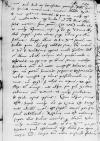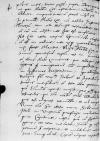Redii huc 15 huius incolumis. Inveni ⌊maiestatem reginalem⌋ de me optime contentam, de qua re mihi ipsi non mediocriter applaudo, cum alias illius maiestatem satis norim. Hanc gratiam (uti reor) nulla alia re mihi comparavi, nisi quod bis ex ⌊Vienna⌋ illius maiestati scripsi satis clare super omnibus, quae illic fiebant. Scripsi illinc et Dominationi Vestrae Reverendissimae semel nec dubito, quin litterae eidem redditae sint.
Non memini, si tunc dominus ⌊Valdesius⌋ coeperat male habere, sed cum illinc abirem, reliqui eum quodammodo in desperatis, uti saepius ex illius servis intellexi. Dicebant enim eum iam incepisse delirare et hoc non parum timoris seu potius desperationis nobis incussit, quod ulcus pestilentiale in i<n>guine non exiit, sed rediit in corpus. Deo Optimo Maximo eum commisi nec adhuc scio, quomodo habeat, ordinavi enim ⌊Viennae⌋, ut mihi scribatur de exitu casus ipsius. Cum adhuc sanus esset, dixit mihi bis ex curia ⌊caesaris⌋ Dominationi Vestrae Reverendissimae ante adventum meum esse scriptum, semel per proprium tabellionem. Resolvit me etiam oretenus super illis tribus articulis, per ⌊maiestatem reginalem⌋ mihi iniunctis, eo modo, ut Dominationi Vestrae Reverendissimae hic praedixerat, quam resolutionem utique maiestas sua aequo accepit animo, sensit enim antea eiusmodi futuram.
 BK, 230, p. 376
Paraverat etiam mihi expeditionem scriptam, sed nondum firmatam, antequam prosterneretur, quam habere tunc non potui propter caesaris abitionem, sed reliqui memoriale domino ⌊Cornelio Duplicio⌋, qui se ⌊maiestati reginali⌋ serviturum obtulit, verum in discessu hidden by binding⌈[u]u hidden by binding⌉ meo tantum temporis non habuit, ut vel maiestati reginali vel Dominationi Vestrae Reverendissimae aliquid scribere posset hidden by binding⌈[sset]sset hidden by binding⌉. Factus enim erat provisor seu profantmeister hidden by binding⌈[ter]ter hidden by binding⌉ exercitus Hispanici et Italici, sed promisit se cum primis scripturum.
BK, 230, p. 376
Paraverat etiam mihi expeditionem scriptam, sed nondum firmatam, antequam prosterneretur, quam habere tunc non potui propter caesaris abitionem, sed reliqui memoriale domino ⌊Cornelio Duplicio⌋, qui se ⌊maiestati reginali⌋ serviturum obtulit, verum in discessu hidden by binding⌈[u]u hidden by binding⌉ meo tantum temporis non habuit, ut vel maiestati reginali vel Dominationi Vestrae Reverendissimae aliquid scribere posset hidden by binding⌈[sset]sset hidden by binding⌉. Factus enim erat provisor seu profantmeister hidden by binding⌈[ter]ter hidden by binding⌉ exercitus Hispanici et Italici, sed promisit se cum primis scripturum.
4 huius, cum ⌊caesar⌋ praecinctus esset ad discessum, adivi ⌊dominum Barensem⌋ illicque inveni dominum ⌊Cobos⌋, utrumque hidden by binding⌈[umque]umque hidden by binding⌉ paratum ad equitandum cumque valedicerem, obtulerunt se ⌊maiestati reginali⌋ et ⌊illius maiestatis⌋ negotiis semper vigilantissime affuturo ms. u(!)
⌈oo ms. u(!)
⌉s. Ubi et Dominationis Vestrae Reverendissimae mentio satis longa fuit, quam ego hic totam hidden by binding⌈[m]m hidden by binding⌉ aliquot vicibus, habens opportunissimum tempus hidden by binding⌈[s]s hidden by binding⌉, apud ⌊maiestatem regiam⌋ et ⌊reginalem⌋ retexui. Fuit hidden by binding⌈[it]it hidden by binding⌉ ⌊illorum maiestatibus⌋ non ingratum ea audire, praeser hidden by binding⌈[er]er hidden by binding⌉tim hoc, quod multis verbis et iureiurando hidden by binding⌈[o]o hidden by binding⌉ affirmabant a plerisque annis nullum fuis hidden by binding⌈[uis]uis hidden by binding⌉se oratorem in curia ⌊caesareae maiestatis⌋ tam magni hidden by binding⌈[ni]ni hidden by binding⌉ficum, tam carum hominibus omnibus, etiam ips hidden by binding⌈[ips]ips hidden by binding⌉i caesari, in tanta reputatione et qui principi hidden by binding⌈[ipi]ipi hidden by binding⌉bus suis adeo bonum lectum, eorum verba repeto hidden by binding⌈[eto]eto hidden by binding⌉,
 BK, 230, p. 377
stravisset. Ubi autem dixi eos et aliquot alios affirmare Dominationem Vestram Reverendissimam plures Hispanos amicos on the margin⌈amicosamicos on the margin⌉ habere quam Polonos, qui etiam vitam pro eadem Dominatione Vestra Reverendissima in discrimen ponere audeant, maiestas regia videbatur gratissimo animo audire, nam risit hilare super hoc non parum et repetiit verba mea ad dominos astantes non sine optimo affectu. Feci hoc ipsum et apud reverendissimum ⌊dominum Cracoviensem⌋ in mensa. In crastino, cum dominus ⌊Tarlo⌋ canonicus mihi obviam venisset, meminit verborum meorum et dixit: „Optimum heri de domino episcopo Culmensi praecornium apud ⌊maiestatem regiam⌋ fecisti”. „Feci” - inquam - „nolens veri quicquam omittere”. Qua re et ipse dominus ⌊Tarlo⌋ et plerique plus affecti mihi videbantur facti, quam antea fuerint, cum Dominationi Vestrae Reverendissimae sine omni dubio tantam existimationem faveant. Nec hoc apud ⌊maiestatem regiam⌋ omisi, quod domini oratores ⌊Franciae⌋ et ⌊Angliae⌋ deliberarunt se velle venire in episcopatum Dominationis Vestrae Reverendissimae, quamprimum id commode facere poterunt, et si hac vice superinscribed⌈vicevice superinscribed⌉ ⌊caesarea maiestas⌋ diutius Viennae morata fuisset, omnino deliberarant ire et videre Poloniam et Dominationem Vestram Reverendissimam, nec dubito, quin fecissent.
BK, 230, p. 377
stravisset. Ubi autem dixi eos et aliquot alios affirmare Dominationem Vestram Reverendissimam plures Hispanos amicos on the margin⌈amicosamicos on the margin⌉ habere quam Polonos, qui etiam vitam pro eadem Dominatione Vestra Reverendissima in discrimen ponere audeant, maiestas regia videbatur gratissimo animo audire, nam risit hilare super hoc non parum et repetiit verba mea ad dominos astantes non sine optimo affectu. Feci hoc ipsum et apud reverendissimum ⌊dominum Cracoviensem⌋ in mensa. In crastino, cum dominus ⌊Tarlo⌋ canonicus mihi obviam venisset, meminit verborum meorum et dixit: „Optimum heri de domino episcopo Culmensi praecornium apud ⌊maiestatem regiam⌋ fecisti”. „Feci” - inquam - „nolens veri quicquam omittere”. Qua re et ipse dominus ⌊Tarlo⌋ et plerique plus affecti mihi videbantur facti, quam antea fuerint, cum Dominationi Vestrae Reverendissimae sine omni dubio tantam existimationem faveant. Nec hoc apud ⌊maiestatem regiam⌋ omisi, quod domini oratores ⌊Franciae⌋ et ⌊Angliae⌋ deliberarunt se velle venire in episcopatum Dominationis Vestrae Reverendissimae, quamprimum id commode facere poterunt, et si hac vice superinscribed⌈vicevice superinscribed⌉ ⌊caesarea maiestas⌋ diutius Viennae morata fuisset, omnino deliberarant ire et videre Poloniam et Dominationem Vestram Reverendissimam, nec dubito, quin fecissent.
Quaesivi in discessu ex illis ... illegible⌈...... illegible⌉ dominis, ⌊domino Barensi⌋ et ⌊Covos⌋, quaenam nova certa ⌊princi
 BK, 230, p. 378
pibus meis⌋ dicere possem super omnibus, quae ⌊Vien hidden by binding⌈[en]en hidden by binding⌉nae⌋ per ⌊maiestatem caesaream⌋ agerentur. Responderunt se mihi hidden by binding⌈[ihi]ihi hidden by binding⌉ libenter impartituros, cum secreti nihil sit. In primis ⌊maiestas caesarea⌋ non credidit ⌊imperatorem Turcarum⌋ tam cito debuisse retrocedere, verum cum iam non adsit nec spes est conflictus, ibit caesar recta versus ⌊Genuam⌋, ibi classis iam est in ordine, nec usquam morabitur aliquando hidden by binding⌈[quando]quando hidden by binding⌉, nisi forte ⌊Mantuae⌋. Misit etiam superinscribed⌈etiametiam superinscribed⌉ ⌊maiestas⌋ sua ad ⌊summum pontificem⌋
rogan(s) or rogan(do)⌈rogan(s)rogan(s) or rogan(do)⌉, ut in ⌊Lumbardia hidden by binding⌈[dia]dia hidden by binding⌉⌋ cum illius maiestate conveniat, quo colloqui possint hidden by binding⌈[int]int hidden by binding⌉, hiems quoque navigationem non impediet, quin hidden by binding⌈[n]n hidden by binding⌉ in ⌊Hispanias⌋ traiciatur. Hoc adiunxerunt: Reliquit ⌊fratri⌋ VIII milia ⌊Italorum⌋ et stipendium pro hidden by binding⌈[ro]ro hidden by binding⌉ duobus mensibus cum tota illa pecunia, quam ⌊summus pontifex⌋ misit pro X milia equitibus hidden by binding⌈[bus]bus hidden by binding⌉ conducendis, qui tunc nondum erant conducti. Reli hidden by binding⌈[li]li hidden by binding⌉quit etiam aliquot tormenta et nil amplius hidden by binding⌈[us]us hidden by binding⌉.
BK, 230, p. 378
pibus meis⌋ dicere possem super omnibus, quae ⌊Vien hidden by binding⌈[en]en hidden by binding⌉nae⌋ per ⌊maiestatem caesaream⌋ agerentur. Responderunt se mihi hidden by binding⌈[ihi]ihi hidden by binding⌉ libenter impartituros, cum secreti nihil sit. In primis ⌊maiestas caesarea⌋ non credidit ⌊imperatorem Turcarum⌋ tam cito debuisse retrocedere, verum cum iam non adsit nec spes est conflictus, ibit caesar recta versus ⌊Genuam⌋, ibi classis iam est in ordine, nec usquam morabitur aliquando hidden by binding⌈[quando]quando hidden by binding⌉, nisi forte ⌊Mantuae⌋. Misit etiam superinscribed⌈etiametiam superinscribed⌉ ⌊maiestas⌋ sua ad ⌊summum pontificem⌋
rogan(s) or rogan(do)⌈rogan(s)rogan(s) or rogan(do)⌉, ut in ⌊Lumbardia hidden by binding⌈[dia]dia hidden by binding⌉⌋ cum illius maiestate conveniat, quo colloqui possint hidden by binding⌈[int]int hidden by binding⌉, hiems quoque navigationem non impediet, quin hidden by binding⌈[n]n hidden by binding⌉ in ⌊Hispanias⌋ traiciatur. Hoc adiunxerunt: Reliquit ⌊fratri⌋ VIII milia ⌊Italorum⌋ et stipendium pro hidden by binding⌈[ro]ro hidden by binding⌉ duobus mensibus cum tota illa pecunia, quam ⌊summus pontifex⌋ misit pro X milia equitibus hidden by binding⌈[bus]bus hidden by binding⌉ conducendis, qui tunc nondum erant conducti. Reli hidden by binding⌈[li]li hidden by binding⌉quit etiam aliquot tormenta et nil amplius hidden by binding⌈[us]us hidden by binding⌉.
Nunc autem hic certa nova habemus, quod hidden by binding⌈[quod]quod hidden by binding⌉ ⌊Itali⌋ in ⌊Ungariam⌋ proficisci noluerint, quia capitanei, nescio quomodo, cum stipendiariis hidden by binding⌈[riis]riis hidden by binding⌉ egerint, res vera me latet. Dicunt, quod a ⌊caesare hidden by binding⌈[are]are hidden by binding⌉⌋ pecuniam ha acceperint et militibus noluerint hidden by binding⌈[int]int hidden by binding⌉ dare eamque ob rem capitaneos aliquot captos esse hidden by binding⌈[se]se hidden by binding⌉.
 BCz, 243, p. 243
Summa summarum: Haec VIII M dispersa sunt, non visa ⌊Ungaria⌋. Bohemorum etiam XIIII M debebant proficisci in ⌊Ungariam⌋, verum quid fiat, nil scitur.
BCz, 243, p. 243
Summa summarum: Haec VIII M dispersa sunt, non visa ⌊Ungaria⌋. Bohemorum etiam XIIII M debebant proficisci in ⌊Ungariam⌋, verum quid fiat, nil scitur.
Nova apud nos haec sunt. ⌊Principes nostri⌋ optime habent, sed dominus ⌊castellanus Cracoviensis⌋ aeger est 4 infirmitatibus: senio, febri, ictericia et cordiaca coeperantque ante 3 dies dubitare etiam cum desperatione, sed iam incipiunt melius sperare, quamvis tepide. Dominus Deus ⌊illius magnificentiam⌋ salvet pro bono reipublicae.
Dominus ⌊Petrus Opalinski⌋ missus est ad ⌊imperatorem Turcarum⌋ orator dicuntque ⌊conventionem huius regni⌋ ob hoc protrahi usque ad Trium Regum festum, quo ille interim revertatur. Ipso absente, mihi iniunctum est docere ⌊maiestatem regiam iuniorem⌋ Allemanice, quare non licet, uti volui, venire in ⌊Prussiam⌋.
Me commendo et servitia mea in gratiam et benevolentiam Dominationis Vestrae Reverendissimae. Quae feliciter diu valeat.
⌊Dominus de Nassau⌋ ivit in Germaniam inferiorem. Adolescentem illum per Dominationem Vestram Reverendissimam illi commendatum non habet, quia morbus Gallicus coegit eum manere in ⌊Polonia⌋.
 BK, 230, p. 376
Paraverat etiam mihi expeditionem scriptam, sed nondum firmatam, antequam prosterneretur, quam habere tunc non potui propter caesaris abitionem, sed reliqui memoriale domino
BK, 230, p. 376
Paraverat etiam mihi expeditionem scriptam, sed nondum firmatam, antequam prosterneretur, quam habere tunc non potui propter caesaris abitionem, sed reliqui memoriale domino  BK, 230, p. 377
stravisset. Ubi autem dixi eos et aliquot alios affirmare Dominationem Vestram Reverendissimam plures Hispanos amicos on the margin⌈amicosamicos on the margin⌉ habere quam Polonos, qui etiam vitam pro eadem Dominatione Vestra Reverendissima in discrimen ponere audeant, maiestas regia videbatur gratissimo animo audire, nam risit hilare super hoc non parum et repetiit verba mea ad dominos astantes non sine optimo affectu. Feci hoc ipsum et apud reverendissimum
BK, 230, p. 377
stravisset. Ubi autem dixi eos et aliquot alios affirmare Dominationem Vestram Reverendissimam plures Hispanos amicos on the margin⌈amicosamicos on the margin⌉ habere quam Polonos, qui etiam vitam pro eadem Dominatione Vestra Reverendissima in discrimen ponere audeant, maiestas regia videbatur gratissimo animo audire, nam risit hilare super hoc non parum et repetiit verba mea ad dominos astantes non sine optimo affectu. Feci hoc ipsum et apud reverendissimum  BK, 230, p. 378
pibus meis
BK, 230, p. 378
pibus meis BCz, 243, p. 243
Summa summarum: Haec VIII M dispersa sunt, non visa
BCz, 243, p. 243
Summa summarum: Haec VIII M dispersa sunt, non visa 




